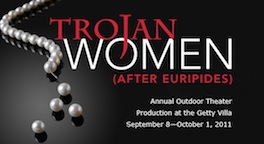HIGH CULTURE UNDER A MALIBU SKY
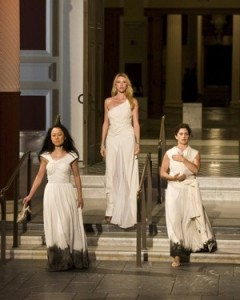 Anne Bogart is not one to shy away from her own directorial eccentricities. As the American Theater’s Queen of Deconstruction, she has had a formidable career looking with fresh eyes at old texts, investigating them and re-inventing them and, at her best, encouraging audiences to look at the plays as if they’ve never seen them before. One of her earliest works, a look at South Pacific from a distinctly political view and set in a hospital ward filled with veterans returning from the war, remains one of the most hauntingly unique and, believe it or not, hilariously funny and gorgeously sung theater pieces I’ve ever seen. It has been many years since I saw that show at New York University (once word got out, it became the hardest ticket to get one’s hands on) but, to tell the truth, some of her subsequent work proved infinitely less enchanting and, at times, either indecipherable or annoyingly obtuse. In many cases, this reviewer would argue, the less you knew of the original work, the more interesting her deconstructed pieces seemed. Let me say right off that her production of Trojan Women (After Euripides) at the Getty Villa is never boring. But this is not so much a deconstruction as an exercise in re-interpretation. And, since Ms. Bogart has what one would call a fecund imagination, there are moments here and there that are bound to resonate theatrically to some degree. And, this time around, the better you know the source, the more you are apt to be involved.
Anne Bogart is not one to shy away from her own directorial eccentricities. As the American Theater’s Queen of Deconstruction, she has had a formidable career looking with fresh eyes at old texts, investigating them and re-inventing them and, at her best, encouraging audiences to look at the plays as if they’ve never seen them before. One of her earliest works, a look at South Pacific from a distinctly political view and set in a hospital ward filled with veterans returning from the war, remains one of the most hauntingly unique and, believe it or not, hilariously funny and gorgeously sung theater pieces I’ve ever seen. It has been many years since I saw that show at New York University (once word got out, it became the hardest ticket to get one’s hands on) but, to tell the truth, some of her subsequent work proved infinitely less enchanting and, at times, either indecipherable or annoyingly obtuse. In many cases, this reviewer would argue, the less you knew of the original work, the more interesting her deconstructed pieces seemed. Let me say right off that her production of Trojan Women (After Euripides) at the Getty Villa is never boring. But this is not so much a deconstruction as an exercise in re-interpretation. And, since Ms. Bogart has what one would call a fecund imagination, there are moments here and there that are bound to resonate theatrically to some degree. And, this time around, the better you know the source, the more you are apt to be involved.
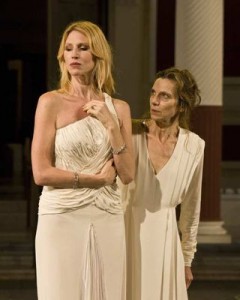 But, on almost every level I can think of, this was one of the coldest and most hateful versions of a play that demands something that clearly doesn’t interest Ms. Bogart or Jocelyn Clark, who wrote the adaptation, or her actors, who attend to Ms. Bogart’s bidding with monolithic dedication: emotional immersion. Clark’s translation chooses academic clarity over poetry. Bogart chooses what one imagines is the stuff of attic theater – deliberate movement – over cathartic revelation. The actors, because they are skilled professionals, do Bogart’s bidding effectively, but they stubbornly refrain from showing feeling, from thrusting us into what is going on inside them. We know what they are thinking; Clark’s didacticism gives the actors lots to say. So, there is all this glacial movement and stylized posturing and dry intonation – they might as well have played it wearing masks – that keeps us at more than a safe distance from the heart of the play.
But, on almost every level I can think of, this was one of the coldest and most hateful versions of a play that demands something that clearly doesn’t interest Ms. Bogart or Jocelyn Clark, who wrote the adaptation, or her actors, who attend to Ms. Bogart’s bidding with monolithic dedication: emotional immersion. Clark’s translation chooses academic clarity over poetry. Bogart chooses what one imagines is the stuff of attic theater – deliberate movement – over cathartic revelation. The actors, because they are skilled professionals, do Bogart’s bidding effectively, but they stubbornly refrain from showing feeling, from thrusting us into what is going on inside them. We know what they are thinking; Clark’s didacticism gives the actors lots to say. So, there is all this glacial movement and stylized posturing and dry intonation – they might as well have played it wearing masks – that keeps us at more than a safe distance from the heart of the play.
And that’s the question that nags at us: What is at the heart of the play?
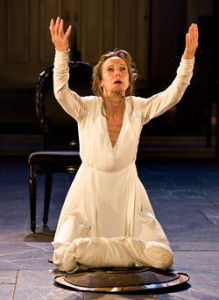 There is first of all the tragic consequence of war, a war that gets fully explained by Poseidon in the opening scene, almost as if we were getting a gnomic lesson in Greek mythology by someone who must make certain that one foot doesn’t move forward until it follows the lethargic movement of the other foot. We watch the actor’s feet more than we listen to his words, because the words are so mundane and calculated. The war is, of course, the Trojan War, in which Troy was invaded and destroyed by the Greeks as revenge for the abduction of Helen, the wife of Menelaus of Sparta, by Paris, who brought his captive back to Troy with him. It has left the royal women of Troy without husbands, and at the mercy of the invaders. The anguish of these women is the emotional core of Euripides’s play. And the effect of having a chorus of women surrounding the four royal women resounds with strong feminist feeling in its original form. But this chorus has been replaced by a male eunuch, which doesn’t make much sense but does provide Bogart, at first, with the opportunity to display some needed humor. And the women – Hecuba, Cassandra, Andromache, Helen – are therefore cast adrift, alone and separate in the relating of the horrors brought upon them by the war. The Euripides play has often been accused of not being dramatic enough, but when put in the hands of strong actors, their individual and collective pain, as in most Greek tragedies, is powerfully and universally felt and realized.
There is first of all the tragic consequence of war, a war that gets fully explained by Poseidon in the opening scene, almost as if we were getting a gnomic lesson in Greek mythology by someone who must make certain that one foot doesn’t move forward until it follows the lethargic movement of the other foot. We watch the actor’s feet more than we listen to his words, because the words are so mundane and calculated. The war is, of course, the Trojan War, in which Troy was invaded and destroyed by the Greeks as revenge for the abduction of Helen, the wife of Menelaus of Sparta, by Paris, who brought his captive back to Troy with him. It has left the royal women of Troy without husbands, and at the mercy of the invaders. The anguish of these women is the emotional core of Euripides’s play. And the effect of having a chorus of women surrounding the four royal women resounds with strong feminist feeling in its original form. But this chorus has been replaced by a male eunuch, which doesn’t make much sense but does provide Bogart, at first, with the opportunity to display some needed humor. And the women – Hecuba, Cassandra, Andromache, Helen – are therefore cast adrift, alone and separate in the relating of the horrors brought upon them by the war. The Euripides play has often been accused of not being dramatic enough, but when put in the hands of strong actors, their individual and collective pain, as in most Greek tragedies, is powerfully and universally felt and realized.
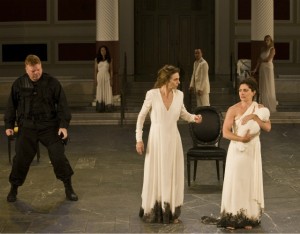 In this version, however, only Andromache, nursing a dead baby, registers any real depth of feeling. Cassandra runs through every room of the Getty Villa that is within view of the audience in what seems nothing more or less than a cheap theatrical display of craziness. Helen struts around, a cartoon of female pulchritude, playing her costume rather than her character, which, in her hands, becomes almost sculptural. Hecuba, whose agony is deepest, intones; at last, some real but short-lived passion comes through the intonation, but hardly enough to make us see what Trojan Women is capable of being in a more dynamic, less mannered investigation of the material.
In this version, however, only Andromache, nursing a dead baby, registers any real depth of feeling. Cassandra runs through every room of the Getty Villa that is within view of the audience in what seems nothing more or less than a cheap theatrical display of craziness. Helen struts around, a cartoon of female pulchritude, playing her costume rather than her character, which, in her hands, becomes almost sculptural. Hecuba, whose agony is deepest, intones; at last, some real but short-lived passion comes through the intonation, but hardly enough to make us see what Trojan Women is capable of being in a more dynamic, less mannered investigation of the material.
It would be nice to say that there are worse things to do than spend an evening in the open air, under the Malibu sky, watching Trojan Women (After Euripides). But it would be infinitely more inviting, and far less forbidding, to just spend a night at the beach.
photos by Craig Schwartz
Trojan Women (After Euripides)
SITI Company
J. Paul Getty Museum, Getty Villa
17985 Pacific Coast Highway in Pacific Palisades
Thursday – Saturday at 8
scheduled to end on October 1, 2011
for tickets, call (310) 440-7300 or visit www.getty.edu
